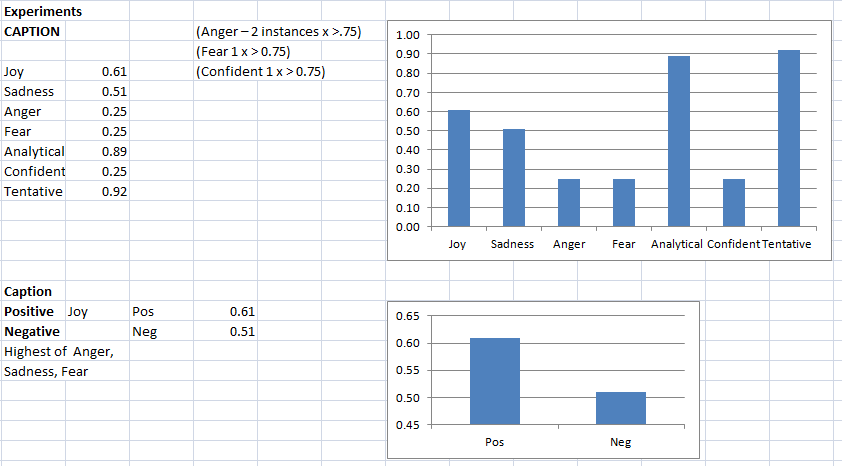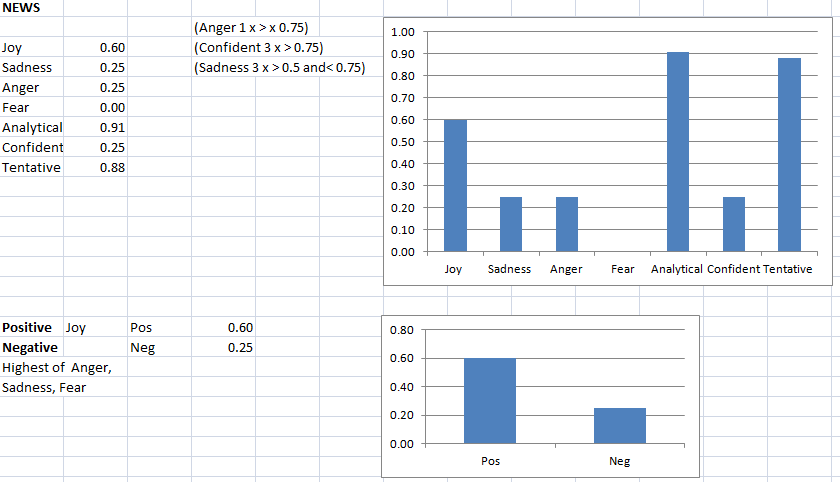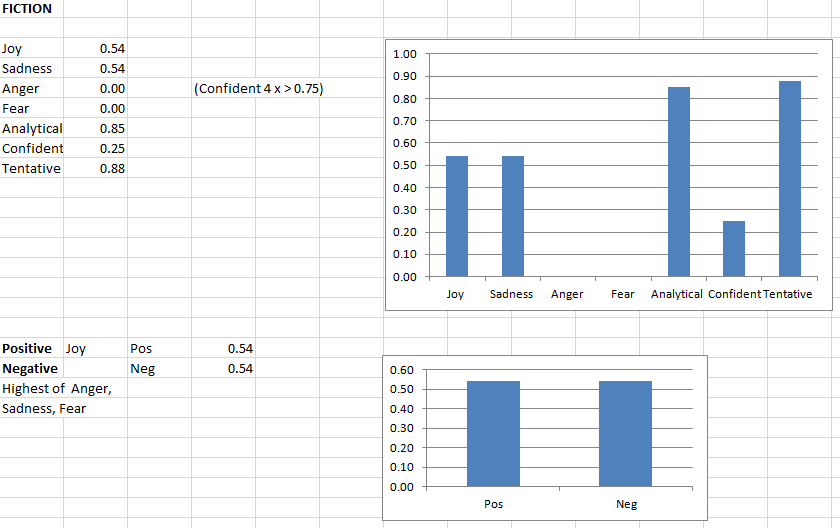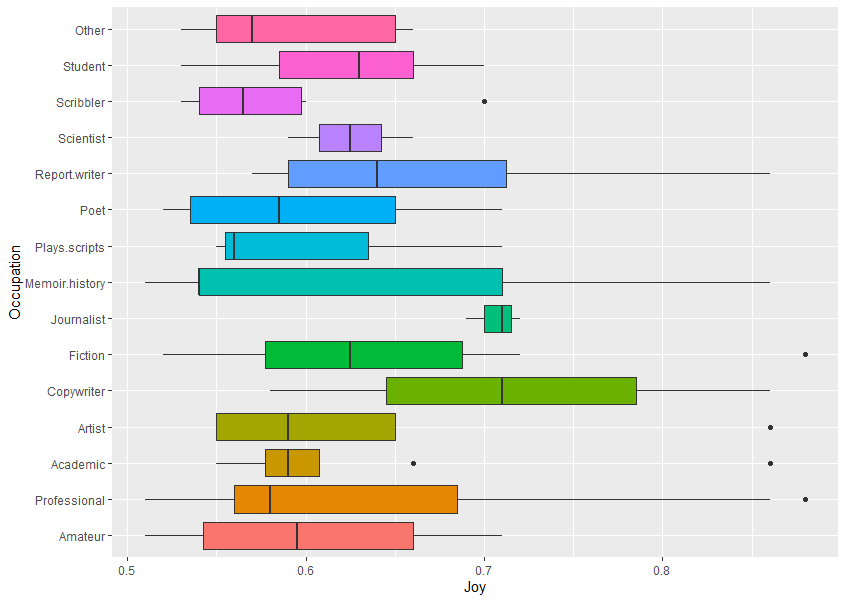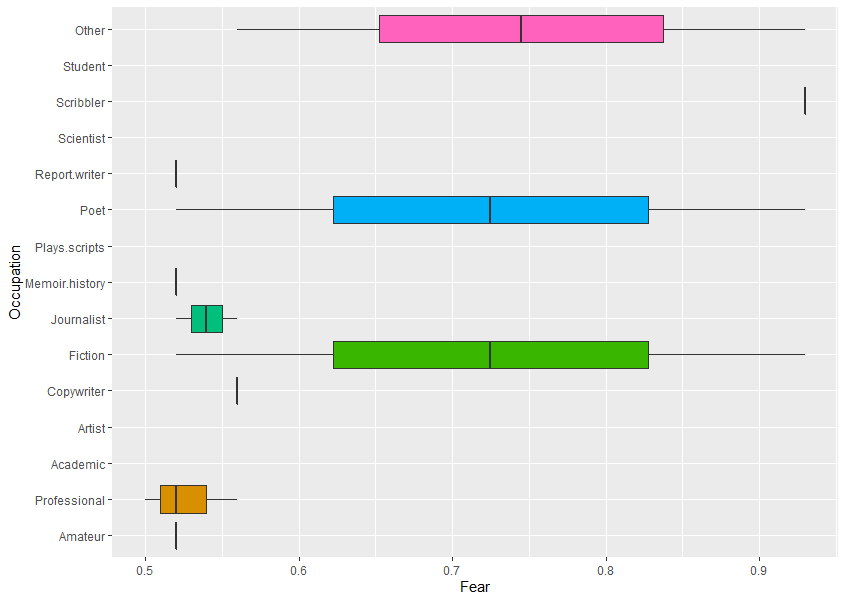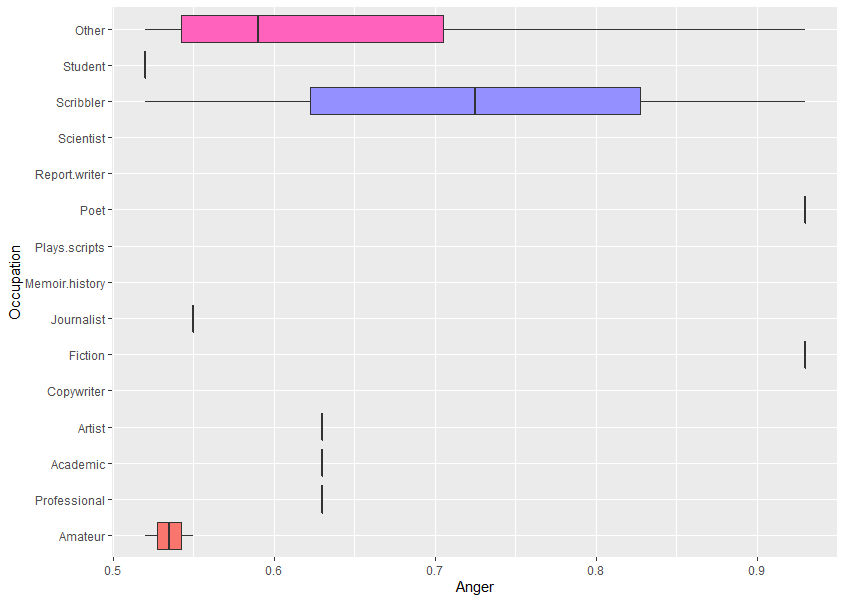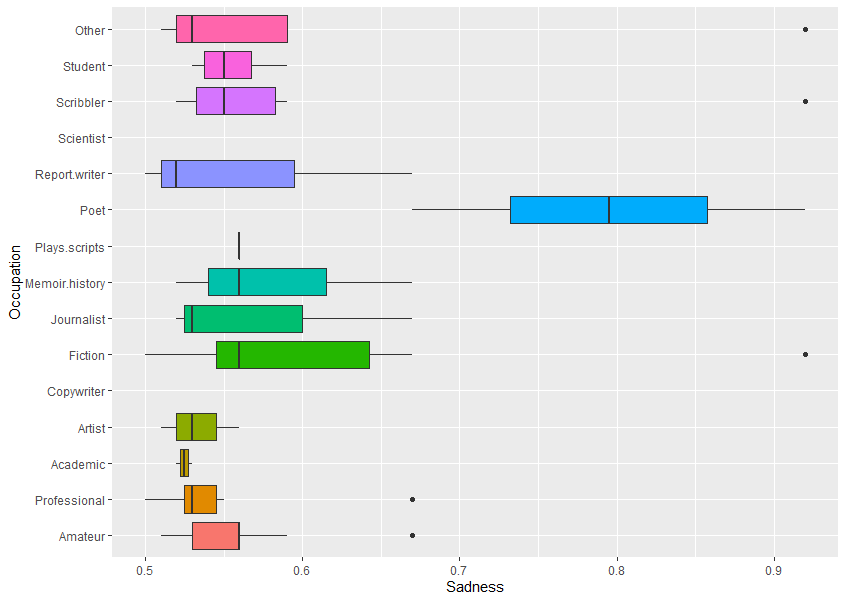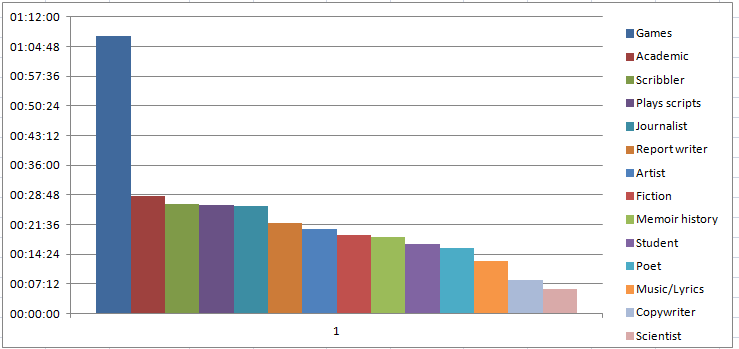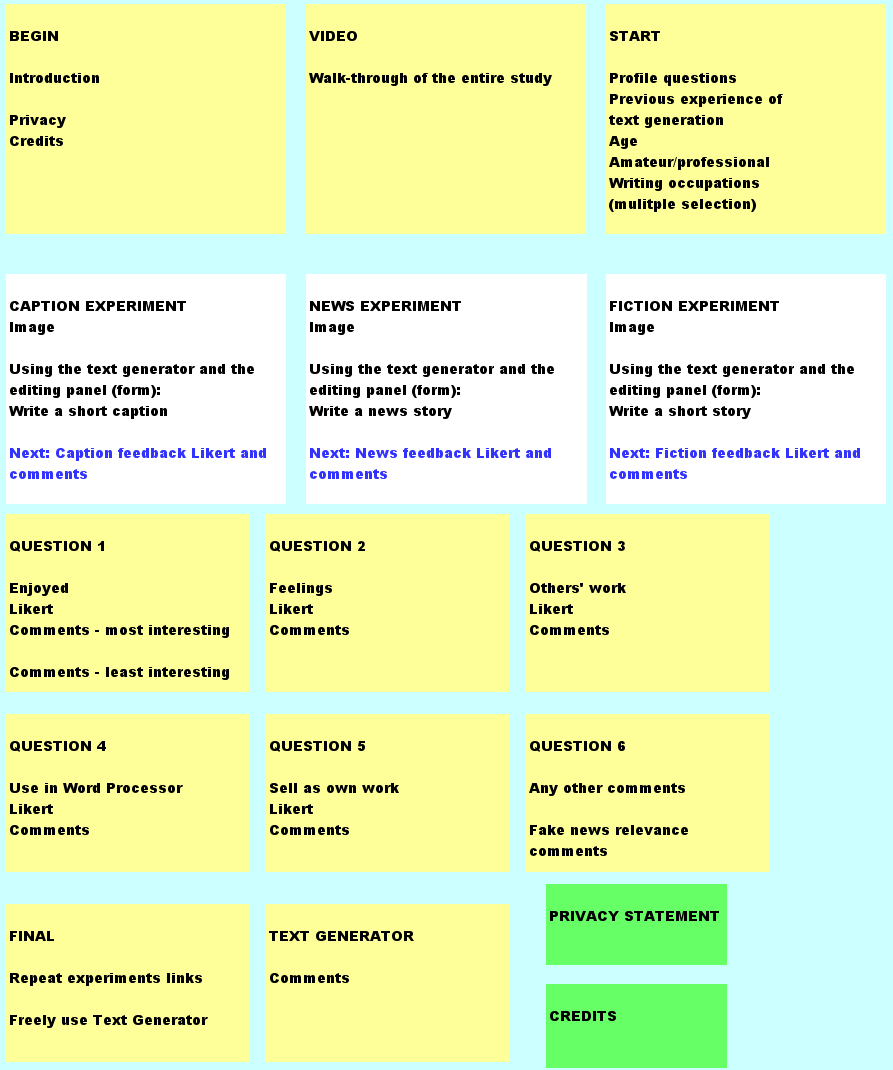AI and Text Talk – Geoff Davis – 26 April 2023 – Computer Arts Society CAS
See below for the transcript of the whole evening, the
-
- introduction from Geoff Davis,
- the four speakers from the book,
- Tivon Rice,
- Ray LC,
- Maria Cecilia Reyes and
- Shu Wan.
- Mentioned in Geoff’s introduction as successful contemporary gallery text-art artists:
- Sasha Stiles – Technelegy
- Mark Webster – Hypertype
Many references are at the end.
Click here for the full Talk video on Youtube.
AI Creative Writing Anthology
The invited speakers in the Talk are in this new book and spke about their work with AI, art and education.

Geoff Davis is the editor of the AI Creative Writing Anthology (Leopard Print London) which has 20 stimulating entries and a lot of extra material.
Each author describes their process and feelings abut using the generators so it provides an insight into using AI text. The book is on Amazon and most other sites and has a large free sample.
Please visit: http://leopardprintpublishing.com/2023/03/25/ai-creative-writing-anthology-20-authors-share-how-to-use-ai/
Computer Arts Society AI and Text Talk
This is a longer version of the Computer Arts Society AI and Text (part of the BCS) talk 26 April 2023. This talk and my next one on 1 June 2023 about AI and Images will be collected into a short document in June 2023.
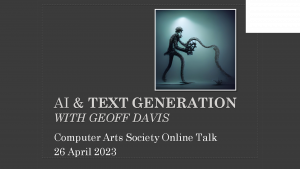
Text-based AI
26th April 2023
INTRODUCTION
Hello everyone. Thanks to everyone at the Computer Arts Society, and Kerry and Maria of the Community Team at the British Computer Society for hosting this talk.
Thanks for Sean Clark for organising the talks series and looking after the Zoom.
This evening we will start with a short introduction, explaining how and why these new AI text generators appeared and came to be so controversial and exciting.
I will show some current AI text-art from Sasha Stiles and Mark Webster, along with a quick look at my own Story Generator.
I will provide an overview of the uses of text to writers and creatives, the technology, ethics, and artificial general intelligence.
Then we will go on to the four Speakers.
Please note that there is a longer version of this talk available, please see the references at the end of the talk. Some areas like technology and ethics are expanded.
I will not be dealing with text used to generate images, in systems such as Stable Diffusion and Midjourney, as there is an upcoming AI and Image talk on 1st June. Please subscribe for that if you have not already done so
The Speakers
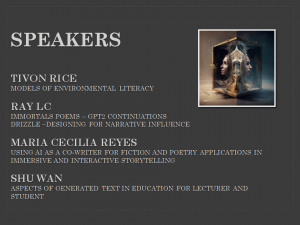
Tivon Rice from DXARTS at the University of Washington
Models of Environmental Literacy
Ray LC from City University of Hong Kong
Immortals poems, which are generated reformulations, and
Designing for Narrative Influence with the Drizzle project –Machine Learning and Twitter communications
Maria Cecilia Reyes from Universidad del Norte in Colombia
Using AI as a co-writer for fiction and poetry and
its possible applications in immersive and interactive storytelling
Shu Wan from Univeristy of Buffalo
Aspects of Generated Text in Education for Lecturer and Student.
So we are covering quite a range here tonight.
This will be followed by audience questions and discussion.
Introduction
A quick note on terminology: ‘AI’ will be used as shorthand for the computer generators. Current systems are not ‘Artificial’ (who decides what is natural) or ‘Intelligent’ (a divisive term with no settled definition; also dualist). But everyone uses the term.
I assume that most people here have used ChatGPT or other similar systems. Yet in my 2021 AI research into how professional writers use generators, which provided a text generator and editor, only 8 out of 82 writers had used them before – 10%.
At that time the public systems like Talk to Transformer and GPT-2 were not widely available. And even if heard of, were looked upon with bafflement and some suspicion. This immediately changed to positive regard after using them for creative tasks (Geoff Davis research ref.).
I will first run through the various ways in which generators are useful to writers and creatives, before we get into more detail.
- Idea Generation: generators can be a powerful brainstorming partner
- Collaborative Writing: generators can suggest sentences, paragraphs, or entire stories based on your prompt input. This is useful if you have writer’s block, or for ambient literature and art (also known as personal content creation
- Style Transfer and Text Transformation: adapt your writing to the style of a famous author, or turn your prose into poetry
- Editing and Proofreading: AI-driven tools can assist you in polishing your work.
- Visual Storytelling: text-to-image AI models can generate illustrations, concept art, or even comic panels based on your written descriptions.
- Cross-disciplinary Collaboration: By facilitating communication between diverse artistic fields, AI can inspire innovative, interdisciplinary projects and collaborations.
- Personalized Storytelling: AI can help create tailored content for specific audiences or individuals, this is good for diversity
- Adaptive Storytelling: AI can be used to create dynamic narratives that evolve and change based on user input, choices, or actions. This can lead to non-linear storytelling, and interactive narratives. This is often used in games.
- Sentiment Analysis for Creative Feedback: AI can analyze the emotional tone of a text, providing valuable feedback on the effectiveness of your writing.
- Creativity as Data: AI can analyze large volumes of creative works to identify patterns, trends, and insights that can inform your own artistic practice
- Ethical Considerations: By engaging in thoughtful and responsible AI practices, you can contribute to the development of a more inclusive, diverse, and ethical creative landscape.
Style transfer is still popular, and much easier to do in the modern generators ChatGPT, GPT-4 and OpenAssistant.
In the AI Creative Writing Anthology book, I have two examples, using a famous optimistic poem about technology, “All Watched Over by Machines of Loving Grace” by Richard Brautigan published in 1967. I simply asked the generator to rewrite the poem in the style of Scottish writer Irvine Welsh, and cyberpunk inventor William Gibson. These came out really well. If you want to take a look, the Irvine Welsh one is on the front page of my website. Previously to do this you’d have to fine-tune the generator by loading new training data.
Demos
Geoff Davis
This is a procedural story generator or PSG – simple but effective.
Claimed by digital art curator Georg Bak to be a ‘precursor of ChatGPT’.
MA4 Story Generator
Mark Webster – Hypertype generative series, using IBM Watson Sentiment Analysis.
Selected several texts and papers on AI and emotion, then analysed them with IBM Watson Sentiment Analyser, to produce a set of texts for use in a generated art series – 300 different images.
Sasha Stiles is very well known, she founded “theverseVerse” online poetry site. Wrote the Technelegy book shot, makes videos, and much more. Sold artworks at Christies recently.
All references are at the end of the document.
I wanted to show these artists as it shows it is possible to have a successful career doing text art, it’s not just a hobbyist thing.
[Edit: two interesting writers on AI and text are Janelle Shane who wrote You Look Like a Thing and I Love You, and does the AI Weirdness blog; and Gwern Branwen who runs gwern.net, please search for them.]
Now I will discuss some of the background.
A Brief History Of Modern Generators
Earlier AI systems used a rule-based approach to create so-called expert systems, which attempted to encode all the actions in a domain, and then reproduce it accurately. This works well for limited domains like those of robots in factories, which have to work accurately with no errors, or help systems with a series of set actions depending on input events. Expert systems did not scale and were not transferable to other domains.
For instance, BRUTUS (BRUTUS ref.) was a ‘Storytelling Machine’ or fiction writing expert system, from 1999, which was a tremendous research effort in conjunction between academic researchers and IBM, AT&T, and Apple Computer, but wrote hardly anything of any general use, and was never developed further.
All of this historical work paved the way for a new approach to AI called machine learning, using so-called neural nets modelled on the brain. These did not attempt to manually describe each step in a program of actions.
The famous artist Harold Cohen programmed a system called AARON in the 1970s to generate drawings in his own style. This is an example of a personal generative expert system. He joked that he’d be the first artist in history to have a posthumous exhibition of new work.
The first neural net was the Perceptron, invented in 1943 but not built until 1958. It was a hardware system for image identification.
In the last ten years, once computer speed and power increased along with a huge increase in the amount of data for training available from the internet, Natural Language Processing and Machine Learning could really increase in usefulness.
Advances in machine learning from data sets continued with Recurrent Neural Nets or RNNs (RNN ref.) and other architectures, and received a significant boost with the invention of the Transformer architecture at Google Brain in 2017.
GPT stands for Generative Pre-Trained Transformer, which means the system is pre-trained on text data and then generates more text based on the statistical likelihood of the next text token. The more text data and the more training (nodes and layers of the neural net) the more realistic the text will be. (GPT ref.)
These systems are generally known as Large Language Models or LLMs (LLM ref.).
A quick list of the main areas of AI and text is:
- Natural Language Processing (NLP)
- Machine Learning (ML)
- Deep Learning (DL, also Deep Neural Nets DNN): A subfield of ML
This is all used to make
- Chatbots and Virtual Assistants – ChatGPT, Google Assistant, Alexa, Siri etc.
- Text Generation and Summarization
- Translation and Language Understanding
- Search
- Transcription from speech
- In our area, Creative Support Tools CST and Copy Writing Assistants
- Many new tools that arrive daily
This is a technical area we won’t go into in this talk. I have provided references, see below.
Because of the adaptable and unpredictable nature of the new generators, they still produce errors and can fail, or can give false answers. The generators are created to give answers, and will always give an answer if asked, so if the data is lacking they will just make something up. These errors are known as hallucinations. The wrong answers are presented convincingly, and can fool naive users, and limit their usefulness in critical areas.
The latest GPT-4 system from OpenAI is far better at world knowledge than earlier versions, even ChatGPT, and gives much more accurate answers. It’s worth mentioning that Open Source systems such as OpenAssistant (OA ref.) are now comparable with commercial systems.
A world model (to prevent nonsensical answers) is thought to be created internally, on the fly, in order to more efficiently process an answer from the vast amount of data in the neural net. Researchers are now seriously claiming actual intelligence for the latest systems, rather than only production of statistically likely simulations (AGI Sparks ref).
General Intelligence
To quote Sebastien Bubeck of Microsoft,“the new wave of AI systems, ChatGPT and its more powerful successors, exhibit extraordinary capabilities across a broad swath of domains. In light of this, we [can] discuss whether artificial INTELLIGENCE has arrived.” (Capitals in original.) This is known as AGI or Artificial General Intelligence, and within Microsoft, Bubeck’s team is devoted to the “Physics of Artificial General Intelligence” (AGI Sparks ref).
It’s worth noting that consciousness is not the same as intelligence.
Intelligence is a goal-orientated ability, such as calculating numbers, playing chess, controlling a robot or car, writing some text, making an image. No mental awareness is required.
In AI research, achievements are denied as the goalposts keep on moving in the definition of intelligence. Now, people say text generators have no intelligence as they are only statistically selecting the next words to output, despite their superhuman abilities in text production.
I won’t even mention the Turing Test.
By the way, non-Western cultures have a different approcah to robots and AI. Japan, Asia, do not have this constant Western fear of impending destruction (which is from intense state competion i.e. war across history I guess).
[Edit, 1 May 2023: Geoffrey Hinton, the top AI researcher at Google, has resigned saying the AI is getting too powerful. Several researchers and observers including Elon Musk, who cofounded OpenAI, have called for a 6 month ban on updating the AI generators, as AI risks are not fully understood. But the main companies and open source groups are in a race to develop bigger and better AI models, so speed of development will increase.]
Ethics
The ethical dimension applies to AI generally, from text to search, control systems and everything else, and is a very hot topic, with many in the AI industry predicting existential disaster, with humans becoming obsolete in a few years. Fear of the robot overlord is also common, based largely on fear of a superhuman intelligence having human emotions and drives such as power mania, need to dominate, and status anxiety (very common in academia and the arts). This scenario is shown in the Terminator movie series.
Actually, no-one knows what might happen, but so far there has been an explosion of creative use in image generators and text uses in literary experiments. Since AI is already here, one would already expect disaster to be encroaching, but there is no sign of this. I prefer to take a more pragmatic approach to AI as a tool, perhaps a very significant one as Bill Gates says: “AI is the most important tech advance in decades.”
The Alignment problem is whether AI values are aligned with human values.
Fake news, propaganda and so on were around a long time before AI arrived. Detecting AI text is hard, and automatic detectors like GPT-Zero are easy to trick so other methods are arriving to separate falsehoods from truth. But since both sides of any political debate claim the truth, this is obviously more of a human problem than a technical one.
Crimes using AI voice mimicry such as virtual kidnapping scams, as well as deepfake videos, are on the rise.
The issue of gender and race bias is also a big topic, although more recent generators such as ChatGPT have guardrails (software protections) in place to reduce or remove this sort of bias. Some commentators object to a left wing libertarian bias in the current generators, such that a new ‘right wing AI’ is being developed, and Elon Musk has also joined in the race with his new company X.AI.
I am currently researching the topic of AI emotional tone at UAL, with a new academic paper due soon. Links for all this are in the references.
Data Dignity and Copyright
The basic creation of large language models is controversial as the text data is taken from the internet. In the case of GPT-4 researchers say quite seriously that the entire internet has been used to train the model. But no-one has ever been paid. The concept of Data Dignity has appeared, which is that all the originators of this text should be paid, by a forensic process examining where it all came from. This is unlikely as it is very hard to separate out data sources even at the level of training the model.
Reddit and Stack Overflow are going to charge for data, which was previously freely available. These companies receive less revenue if AIs take over computing support, discussion and code help roles, using all their original data to do so (Lanier ref.).
In the field of text to image, some copyright court cases are in progress regarding art images used to train text to image generators, as individual artist styles are easily identifiable (Loizos ref.).
Objections
Some artists object to AI in principle, for high energy usage, or because it might reduce authorship or creativity. However, in my recent study, only 8% of 82 professional writers felt they did not own the generated text. Many creatives already use code for generative art, or use programmed filters in tools such as Photoshop.
There is a huge grey area as AI is already part of the infrastructure, used in editors, search, predictions, translation, learning and so on. Most see AI as advantageous in terms of productivity increase, extension of creative skills, new art forms, and practical uses in medical and legal support in poor countries with limited professional resources for ordinary people.
There is also some debate about the amount of energy used to train the systems, but these costs are low compared to general power use. The computing industry uses a huge amount of energy for general activities such as entertainment, administration, etc., so a little used for next generation technology is a drop in the ocean. However newer models are designed to use less energy.
Class and Progress
Most mainstream articles about AI start with an alarming ‘end of civilisation’ quote, often from someone like Elon Musk. In the case of computing, the new technology has been changing working-class jobs for decades, but that has been promoted by the media as thrilling progress. Now that typical middle-class jobs like journalist, academic or lawyer might be affected, existential dread is promoted instead. More academic studies of potential threats from AI include the influential book Superintelligence by Nick Bostrom (Bostrom ref).
Generating Computer Code
Warning: Can produce insecure code. Always tell it to make secure code. Check if you don’t know.
Visit
https://www.malwarebytes.com/blog/news/2023/04/chatgpt-creates-not-so-secure-code-study-finds
https://arxiv.org/abs/2304.09655
Using generators for code is also a big area now, with GPT-4 scoring 10/10 on programming employment tests at expert level. Although it still needs guidance and reviewing, generators code clearly and also add comments, and can explain their steps, which makes it useful to beginners and experts alike. It speeds up code production from hours to minutes.
In the AI Creative Writing Anthology which I recently edited, Brian Reffin Smith, the winner of the many electronic art prizes and a member of Computer Arts Society, has an imaginary chat between ELIZA, the first computer therapist, and Karl Marx’s statements in the Communist Manifesto. He then later asked ChatGPT to produce a new version of the ELIZA code with many extensions for art assessment, which is now available to view only, on Facebook (Brian Reffin Smith ref.).
I have used GPT-4 to code modern versions of my old generative art, originally written in BASIC.
AI code assistants like Copilot from Microsoft using GPT3 can be run with Python and other languages. Already up to half of Python code is produced by the Copilot assistant. (Copilot ref.) If this is true of course.
Before we go onto the speakers, I will run through some other areas.
Ambient Art – Personalized Content Creation
There is a field of ambient art and literature where people generate for fun, as a pastime, with no intention to create a final product. Interesting outputs such as generated images, memes or poems and lyrics might be deleted after creation, kept private or shared on social media (Ambient Art ref.).
Games
AI can also be used in game environments to create dialogue, descriptions, control characters, generate scenes, and control plot lines (Games ref.)
Creativity of Older Generative Systems
Many commentators have commented that the older generators such as GPT-2 or the Open Source GPT-J 6B are more useful for stimulating creativity, as the outputs are more randomised, which was the point of old experimental systems such as Dada’s ‘Exquisite Corpse’ or William Burroughs ‘Cut-ups’. The older generators are also easier to fine-tune with one’s own work.
However with newer systems from ChapGPT onwards, you can just ask it to rewrite text in the style of James Joyce, or Irvine Welsh, etc., or put in a sample of your own prose for it to copy the style from.
The newer models are usually controlled with something called prompt programming to get a specific output.
Creativity Assistance & Creativity Support Tools
It is worth noting that nowadays many artists use AI for part of their work process rather than all, perhaps for creative ideas or copy writing. The generators can be seen as expert assistants ready to do any task, a bit like a ghostwriter or art team.
I have a hybrid generator and editor Story Live, which I made along with Fabrice Bellard using his Open Source Text Synth. This is freely available, and also has a Text to Image generator and Translation (Story Software ref.).
There are many attempts to create a novel-writing AI system, but we do not examine those here. Some of these are in the references.
There are many attempts to create a novel-writing AI system, but we do not examine those here. Some of these are in the references.
I have researched and developed creativity support tools CSTs as they are known, with a zooming storyboard tool called Story Software still available in various versions.
I also have a hybrid generator and editor Story Live, which I made along with Fabrice Bellard with his Open Source Text Synth. This was made for research purposes but is now freely available, and also has a Stable Diffusion text to art generator and Translation (Story Software ref.).
Speakers
Tivon Rice
RAY LC
Maria Reyes
Shu Wan
Geoff Davis
So I think we’re kind of ready for the speakers now.Then there’s a question and answer discussion period at the end of the speakers. So hello, Tivon.
Tivon Rice
I’m Tivon Rice, joining you from Seattle, and I really appreciate the opportunity to share what I’ve been working on lately. I am an artist and an educator teaching at the University of Washington’s department of Digital Arts and Experimental Media. Quick overview. For the past probably about six or seven years, I’ve been working with computer generated texts like this one we see on the screen generally to accompany my visual and sort of time based projects. And my work with machine learning or AI or whatever you want to call it, tends to oscillate between working with these systems in my studio in a purely creative mode, but then also sort of switching and critically examining how these emerging systems function in society or imagining how they will function in future society. And I explore these ideas through my teaching, through workshops, conferences, and the like. So I want to start by showing you part of a trailer for an experimental film that combines digital animation, photogrammetry, and a number of AI generated narratives. These are specifically fine tuned GPT-2 models, as Jeff sort of described sort of from an earlier era.
But let’s take a glimpse of this video and then I’ll further describe the project. So here we go. We’ll watch about a minute and a half of this.
VIDEO (spoken word and animations)
Models for environmental literacy.
Video Speaker 1
What is an island? Is it a graveyard? In what sense is it an island? Does an island denote a sense of spatial absence?
Video Speaker 2
I’m afraid of the absence. It seems to be forming on me. Its dark forms disturb me. The whole place silent. The stones are blur.
Video Speaker 3
All of this anxiety and worry goes hand in hand with an ongoing process of change. A change that, although not explicitly recognized by this program, has become obvious to all.
Video Speaker 2
This, for me, is the essential paradox of our stories. In finding our way within the world, we humans invent or modify or redefine reality in ever larger and more incomprehensible ways. So our words are not only a vehicle for revealing the world to the reader, but also a vehicle for revealing the reader.
VIDEO sample ends.
Tivon Rice
Okay, so the rest of the trailer and actually the entire 35 minutes minute film are linked on my website and demo pages. So I’ll leave that to you.
But I’d like to give some background to the research project that sort of spawned this about three years ago, actually, when I was living in Europe at the time. And I guess reflecting on the time that I was living in Holland and presenting my recent projects at exhibitions, conferences, and workshops, I found that many of the conversations that arose around AI and other digital techniques technologies asked how we could apply these ways of seeing and understanding large systems to the topic of the environment. And I think these questions are, of course, a product of the times.
But I also came to understand how the Dutch landscape, which may be one of the most highly engineered landscapes in the world, also provokes this kind of critical attention about the environments. So I was asked to participate in a number of, like, artistic research projects that sought to apply emerging forms of image production, mapping, world building and storytelling to the topic of the environment. We were sort of focused on very specific environments, like the barrier islands on the North Sea coast of the Netherlands.
Or more broadly, how can we begin to imagine ecology and the environments from new perspectives, possibly even and non human perspectives? Non-human centered perspectives. So this project, Models for Environmental Literacy, brings together three areas of research, one being field trips and workshops in which groups of artists, ecologists, authors, and musicians sort of visit these sites at the boundaries of human involvement and environmental change.
The second area would be natural language processing research. Earlier, I was working with a tool called Neural Storyteller, a very early RNN NLP model. But seeking to update these systems. How can they be made more accessible to broader creative communities like my students and those participating in my workshops? So I focused on the idea of fine tuning GPT-2 models.
The final area of work would be to develop a series of films, which we saw the intro right there. How could these films creatively reflect on the research as a whole, combining digital image that were collected at these sites, these virtual environments, with these narratives generated through fine tuned GPT-2 models? I’ve already touched on the field work that went into this. So because this work preceded Chat GPT or even GPT-3, I used the medium version of GPT-2 as a starting point. And this model is okay, maybe the glitches are kind of charming, but it’s also small enough that it can be fine tuned on a conventional computer that has a GPU. So I was able to fine tune three new language models of my own. And these are the voices for the film.
A number of different ecologically concerned AIs, one trained on eco philosophy, one on ecofiction, and one on very recent scientific reports about the current environmental crisis. And this is a good starting point for describing the position that I take when co-authoring with AI, and I identify at least three absolutely critical areas of knowledge that need to be built around working creatively with these systems.
First of all, we should know as much as possible about the language models data set. And so in this project, because I collected and trained or fine tuned my own data sets, that we see sort of brainstormed here, I believe it’s a lot more transparent and deliberate than working with black box models like GPT-3. But even so, moving forward and working with these large language models, I think it’s important to think about the very large data sets of arbitrary text scraped from the web, as Geoff described. How do we understand the tone and content, the truthfulness and the bias inherent in language that’s evolved on the Internet and that was ultimately used to train Chat GPT?
The second body of knowledge or skill set that I place importance on involves inference. How do we prompt these models to create text that is meaningful or suggestive or provocative to us? If we ask boring or superficial or unstructured questions, we’re going to get the same. In return, we’ll get this kind of like autocomplete behavior that outputs an endless, banal sameness. So how can we deliberately craft prompts that are more likely to produce interesting outputs? With these films, I thought about the logic of prompting and how GPT-2’s outputs could be used successfully successively as the following prompt it’s kind of like a feedback loop. So the logic in the dialogue of the first chapter is actually circular. One model is asked a very simple question tell me what you see. And the response to the output becomes the prompt, the input for the next model. So in this dialogue, the entire paragraph from the Scientist becomes the prompt for the philosopher, and the philosopher’s output is then the prompt for the author, and so on. And visually, the first chapter is focused on this strange Dutch island that’s called the Isolo, the Eye of the ISIL River. It’s like this perfectly circular manmade island designed to isolate toxic sediment generated during the engineering of the farmlands in the north of the Netherlands.
So the film’s animation sort of studies this uncanny, circular landscape and the surrounding waters in stark black and white. The second chapter is called Whisper Poems, and the logic of that dialogue is also circular, but only two or three words from the previous output is considered for the following input. So, like a whisper poem or a game of telephone, there’s some continuity, but also a greater chance of misunderstanding between the different models as the story evolves. That chapter is focused on the small islands surrounding Helsinki in the northern Baltic Sea. Sort of paradoxically. While the Baltic rises at 1.5 year, the islands in that area also rise twice as fast 3 year as a result of postglacial rebound. So again, these small bits of land presents a sort of paradoxical image in terms of human time frames, a sort of anthropocentric time frame, or perception of time or history or geo sort of temporal situations. So this film’s animation studies the sort of isolation and invisibility of number of these small, rocky islands and the surrounding waters. The final chapter is called Echo Chambers, and the logic of this dialogue is a feedback loop in which one model’s output becomes its own input over and over again.
So thus, each character has a much longer monologue without being in dialogue or being interrupted by the other voices. And each text is prompt with a very simple question where are we? This chapter is visually focused on a field trip we took studying toxic algae growth in Zayland, southwest Netherlands. And these blooms are caused by, like, excessive chemical use in agriculture. The over engineering of the Netherlands delta works after the 1953 flood. So the film’s animation studies the strange color and sort of dense texture of algae surrounding another number of islands in this estuary, which is essentially a dead sea. I said earlier that there are, like, three areas of knowledge that I feel need to be built around working collaboratively with NLP systems like these, understanding the underlying data sets, carefully crafting our prompts during inference. And the final idea, I believe, is deliberate co authorship of the outputs. So it’s important to be honest and say that I do step in and give the final form to these texts. And this decision to edit or gently reorganize the output from the machine learning system is my response to all these questions surrounding the artistic agency of machines.
Should we initiate these systems and then step back and take whatever they say to be the final raw output to sort of demonstrate that the technology works? Or are there moments where we can reinsert ourselves into the process and make decisions about how the output resonates with our own poetics? So, for me, in cultivating this kind of collaborative relationship with AI, what I’ve found is that as I observe a machine learning system develop some kind of understanding about language, that my own understanding of language begins to shift as well. And I can see from sort of like third person perspective how language evokes images and narrative decisions in my work. I’ll leave it there. Look forward to hearing from the other presenters. Once again, thank you for having me, and I hope we can chat about some of these ideas. Thank you.
Geoff Davis
Thanks a lot Tivon. That’s a really good piece. It’s good to see you explain it because I’ve only seen some of the text before, so that’s excellent. We’re having a discussion at the end.
So Ray, if you want to start.
Ray LC
Hi everybody. How are you? Fascinating work by Tivan.
What I do, I’m an assistant professor of Creative Media at City University of Hong Kong, and I’ve been there since 2021. I have a neuroscience background. I got a PhD in neuroscience, but basically since about 2017, I’ve been working in Creative Media arts design this area. So I’ve also been using GPT-2, and because it’s got these quirky ways of expressing itself, kind of helpful for generating poetry, which is what I’m going to show you today.
I run the studio for Narrative Spaces, which involves using basically looking at humans interaction with machines and with AI as our starting points for investigation. But we work with basically interdisciplinary, pretty much anti-disciplinary crowd of people, like roboticists and performers. We work a lot with dancers, et cetera, et cetera. So this is our page if you’re interested in taking a look. [See references.]
The project that I will share today mostly will be about this work called Imitations of Immortality. It’s also a book, by the way, that was published, I didn’t bring that up. This is also a book that was published by Floating Projects Press. And so it looks like this classic poetry book written by two people, basically, me and GPT-2. Although I also want to be frank, is that I also curate GPT-2 as well, just like what Tivon was doing. This web page basically is kind of a web version of the book.
So what’s the workflow here? The inspiration here is that some of you might know William Wardsworth. Well, you probably all know William Wordsworth’s collection Intimations of immortality. So what I want to do is actually create a bunch of poems that were modeled on famous poems. A lot of them are British poems, actually. So, for example, there’s Dylan Thomas. Do Not Go Gentle Into That Good Night. There’s Alan Ginsburg’s Howl, for example. So what I did first was I wanted to make a kind of a variation on that classic poem. So today I don’t have time to show everything, so I’ll try to be interactive a little bit. So I’m going to show you my version of Elizabeth Bishop’s poem, which some of you know is called One Art.
“The art of losing isn’t hard to master;
so many things seem filled with the intent
to be lost that their loss is no disaster. “
So it’s a villanelle form, by the way. It has a particular rhyming scheme. So what I wanted to look at was what happened if I try to write a variation on this poem. And then I’m going to ask GPT-2 in this case to write a variation of this poem, with my help, of course, because I’m curating the text by giving it the Elizabeth Bishop voice. Basically, I gave a bunch of Elizabeth Bishop poems try to find that voice and then also to give it a starting primer. That’s how the GPT stuff was working back in those days. So I give it the first stanza from One Art and have it try to generate the rest of it. So in the interest of being in-depth versus in-breadth, I will show you my version of the poem. By the way, this is kind of interactive website, so I know things are starting to disappear because they’re getting forgotten. I’m sorry about that.
[Shows poem.]
Okay, so anyway, so it says the science of forgetting is not inscrutable. So much information pokes at our brain for attention that to forget is it is forgivable. So you can kind of see like this variation of the poem actually tries to be kind of a micro version of trying to write a variation. I try to follow all the structure, et cetera, et cetera, even the things where Bishop does parentheses with exclamation marks. For example, here the joking voice, a gesture I love. Or write it. That’s kind of the one main point of that poem. So I try to kind of reproduce those things in my way of writing it as well. Okay, so anyway, so you can go and watch this, including the ending. I kind of give that blah, blah, blah is unforgivable. So I kind of try to vary it that way, too. So, of course, the GPT version will not be that way. I’ll just show you because this is what this talk is about. Here’s what the GPT version comes up with. And just keep in mind it is curated, but I try to do it so that each stanza is what GPT wrote.
I choose the stanza, but I’m not going to rewrite this thing for GPT, right? Because that would be pretty unfair. But I did have to insert some line breaks here or there to make it work out. So again, this is the original poem. The art of losing is an art to master. This right here I’m showing you right now, hopefully you can see, is the GPT version, right?
[Shows pages from book.]
So it starts with the original stanza, and then it says the music is part of the song, though it be sung. The other hand is silent till the other side finds its master. The man that gives knows all. So as you can see, it kind of sort of has a voice, but it’s not really following Elizabeth Bishop it’s not following that logic, but it kind of keeps some of these interesting things. Like, for example, in the middle there, you can see thus close the truth. Parentheses, grab it and run. Exclamation mark, parentheses. How come no one has seen such a site for years? The stranger the disaster, the farther a word. It’s learning some form of this poem and kind of like regurgitating it in a kind of a funny kind of way, funny to us, quirky kind of a way.
And actually, if you see on the bottom there, they actually use this kind of disaster thing here as well. So it’s kind of learning to say things from the poem in this kind of fresh new style. So this is what the book of poetry is about. So in the book itself, you can basically well, you can actually pick up a copy if you’re in Hong Kong, but we’re trying to make it available in the future. Actually, I have it with me. I’m sorry, this is kind of random, but I do actually have it with me and just to show the form of the poem a little bit. So once you have the book in front of you, it’s also kind of a nice kind of thing. And the way I kind of you can’t really see it because I blurred out my screen. But the way I also design a book is also I basically don’t say who it’s by. So I put my poem and the poem by GPT-2 on opposite pages. So people are kind of forced to just read it without knowing kind of the authorship. Now, this was also published into a paper at RTech, an ACM conference.
And in that paper, basically just the short answer is that I basically asked, I gave particular stanzas of the poem to people who are reading it for the first time, like kind of on a survey. So what I found basically from that study is that, first of all, if I just give them stuff from my poems and from the GBD two, one more or less the whole corresponding stanza. If I give them those things, they’re not able to distinguish which one is human made versus which one is machine made, right? If you ask them, one of these is like the machine generated which one? It’s like 50 50. They can’t tell which ones are mine, which ones were the machine. But if you ask them which ones are more expressive, so you don’t tell them that the stanza was by me or by the machine. But you just ask them how expressive it is, right? You just ask them to judge how expressive they are. And then you go back and figure out which poems have a score of one versus a score of seven. Then you actually can see a significant difference where the poems I wrote are more expressive.
Without them knowing the identity, they found that the poems that I wrote were more expressive. So what that tells us is that actually, I believe that the readers have this kind of unconscious knowledge of who’s writing the poem, right? Because unconsciously, they cannot tell you who wrote it. But then there’s something about that poem that still strikes them differently. There’s still something about the way I wrote the poem that was more expressive to them in certain ways. Anyway, so that was kind of my take away from this. I had a great time with this project.
I know that Geoff was asking me to show you about some comics and things like that so you can take a look at this. Comics for climate change. Actually, I wanted to also echo Tivon’s work because I also work with climate change, and we used Twitter to get our feeds, our data to generate climate action text as well. So those of you who are interested, you can check out that work, which is in Drizzle and also in this Tamagotchi game that we created that also speaks in machine learning generated language. And this game in particular, you can actually also play online. So it’s like this Tamagotchi game that you can kind of have fun with and play with.
Anyway, so thanks so much and looking forward to discussing more.
Geoff Davis
Thanks a lot, Ray. That’s a really interesting talk. Very good to see the work. Apart from the poems, the Drizzle and the Tamagotchi are really interesting. So maybe we’ll do something else some other time. But thanks a lot. I’m going to put the next speaker on, Maria Cecilia Reyes from Colombia.
Maria Cecilia Reyes
Thank you so much for the invitation. I want to share my personal journey collaborating with artificial intelligence systems on co-generating worlds, fictional worlds, universes with words and images, but also what have been my thoughts about this collaboration. And I realized that there is something that is not artificial in this relationship with artificial intelligence. So my journey started not so long ago in 2018, at my work in the National Research Council of Italy, I was doing research about conversational agents in the field of education. At that time we were developing a tutor bot to help students that were engaged in massive online open courses. However, working with technologies and experts in the field, I couldn’t refuse to think about creative applications for conversational agents, especially vocal interfaces.
So for my creative life, I wanted to use a conversational agent to help people to edit a film made by pieces of videos from YouTube. I also started to work on an immersive space in a womb of a mother in which we could have a conversation with that mother by being physically immersed in that type of womb.
So we started to work on a mock-up and get projects and ideas that start, but then they have their own time to evolve. At the time I also had the opportunity to advise a couple of master thesis that were using chat bots. One of those was for helping elders through a device called Kibi, an intelligent device that were alerting, caregivers about the state, the physical state of the elders, and also had a vocal interface for the elders themselves to remember them when to take some pills or give them some advice, remember them to call someone. And another thesis was the development of a chatbot for a museum so users, visitors of the museum could have a previous experience before going into the Museum of the Electric Technique in Torino in Italy. But then I received a message in an email in 2019 from a friend and he says I’ve been writing poems since I’m a little kid and I don’t share very often my poems, but I share with personal friends. And this friend wrote me this. I put the two first lines of your poem to use the voice to communicate love. It’s not about putting words together into this new website, Talk to Transformer, which is GPT-2.
And the results were surprisingly good, you can do it again and again with different results each time. I had some good laughs thinking up the beginning lines of some surreal stories and seeing what the AI comes up with. But with your poem, the results were more artistic and not pure comedy. So I was very intrigued by this message.
I started to use Talk to Transformer at the time to give some prompts and some first lines of my real poems and see how the machine would react and what it would do with it later. So yeah, as a hidden poet, I started to show my poems to the machine, to any machine that I would come across with. So one of those was Talk to Transform and then Story Generator in 2020. Then when Night Cafe came out, I also started to give some lines of poems to Night Cafe to see what kind of images it would create and then MidJourney more recently. So the only poem that I saved from all these iterations was the poem that was published in the volume that was just published, AI Creative Writing Anthology, thanks to Geoff. I kept two images prompted by two of my poems.
[Shows tow images.]
So why these two images? I don’t know why in these nights when you stay awake and just experiment, sometimes some of that work just has a very short life but leaves deeper thoughts. So one of the images that I saved was this image of Genoa. It was a time in which I wrote a very angry text about the city. As an immigrant, I was going through many personal battles by giving this prompt, this idea of a Genoa in flames that the machine created this representation that stood to me and represented that feeling that I was going through at that time.
The other image is a bit more even more deep and personal. The first one was NightCafe. And this is MidJourney instead. And it’s poem about a moment in which two people that never got married in life while they were alive, they get together in heaven after passing away. And this is images really got a big emotional develop a big emotional connection with myself. But then in those moments and I think most people or the reactions that I get from my colleagues and friends experimenting with AI, I feel it’s sometimes very similar to what happens with Horoscopes.
Sometimes the confirmation bias that you kind of expect to have an idea of what would you like to get from the machine and then from any of those phrases or images that you get, then we as humans, we make our own conclusions and adapt those information to our lives. So what is that kind of prediction that sometimes AI chatbots can have for the use of common people that want to get that information into their own lives? So this is a question about where are we standing when we ask something to the machine?
I’m a PhD in digital humanities and I have been working in interactive digital narratives, especially in immersive interactive films. That’s my field of studies. So as a future research interest, I’m very interested in imagining AI generated immersive and interactive narratives. So I imagine being immersed in the movie or in the film, in the narrative and leave the control, the creative control to the machine to create the visual environments in which we are immersed, but also to create different outcomes of the story while we are interacting with that story in real time. So the machine and this is just provoking some ideas based on our cognitive data.
Some choices, conscious choices that we can make during the journey, the narrative. We can maybe talk to the machine. Maybe we can enter some text. Maybe we can just make some choices. And then the machine will create new story plots or continuation for the story. But also what if we interact with the machine and with the fictional universe, with our biological data and our breathing or our heart information and from there the artificial intelligence can take over and make the story more stressful or give us a break or take us into a more fantastic world.
But I’m concerned about two main aspects. One is coherence, that was another issue that I faced experimenting with some GPT-2 tools. Sometimes I wanted to just let the machine take over, but the coherence was not fully there. And the other one, especially when we talk about interactive narratives, is the dramatic progression. We want to make sure as creators, as storytellers, that our spectator or user is going somewhere, is going to experience a climax, a moment of euphoria in which everything makes sense and the narrative experience gives you that reward of a climax. So one very famous interactive drama is Facade by Michael Mateas from 2007. It is a conversation with this couple in their apartment and he uses an AI system. As users we interact with them through text and then the story develops in separate ways.
There are some plot points that are fixed and somehow guide the story so it doesn’t go everywhere. Another interesting project is Nothing for Dinner computer based interactive drama from 2015, and the group of Interactive Drama Tension or ID Tension from Switzerland that have been working on AI and interactive drama for some time now.
Just as a final thought, I think we humans are the ones that generate meaning that we make sense of what the machines are proposing and we are the ones that feel the effects of that material that is produced by the arbitrariness of the machine. So that’s why I think there is nothing artificial here in this relationship between us as creative and the artificial intelligence.
Thank you so much for your time.
Geoff Davis
Thanks Maria, that’s very interesting.
Now we’re going to move on to our last speaker, Shu Wan, who’s from the University of Buffalo.
Shu Wan
Hi, how are you guys? I’m Shu Wan. As you can see, the title of my piece today is Chatbots. During scholarship, how do I teach GPT in a history course? As Geoff said, I’m a professor in history at the the University of Buffalo in New York, USA. So I’m very happy to present my pedagogical research on how to protect students from using ChatGPT, and help students to use it. But not in violation of academic integrity. That’s the big issue.
So now I’ve seen American higher education. Last December 2022, I was assigned to teach an Asian History class in the term of January 2023. Well, a lot of time I wanted to use ChatGPT and it became a big issue. Everybody talked about that. That was the controversial issue of introducing or allowing the use of ChatGPT in a classroom. But once I decided to introduce it to my students in class by designing ChatGPT sessions, and adding it to my syllabus. So, on the first day of my class on January 4, I demonstrated magic of ChatGPT to my students.
After showing this slide [IMAGE] and playing a video of Canadian philosopher Jordan Peterson’s quarter of ChatGPT, I enter an example of prompt real lilm Large Emperor into the interface into the interface which output a brief introduction of the film as follows.
You can see here on the slide. And then I told students to use a high tech tool ethically, such that it must help them when they encounter difficulty employee powering, for exam.
However, I told students it’s not a good idea to replace your brain with a machine when doing a review essay. The reason I mentioned the film essays is because in my class students were assigned to write a film review about a film related to Asian history. And then finally at the end of class, I told students it certainly violates academic integrity if you use ChatGPT in completing your writing assignment. So please don’t do that.
And so in the following class demonstration, I instructed students to complete the Human Machine Collaboration Writing Assignment class, which consists of two sections. The first one, play with the text generation interface to produce machine made text and then manually, I mean by hand, compose a reflection on the influence of AI task generation technology on academic integrity.
The reason I chose to use Open Source things instead of ChatGPT is because it’s because of my intense concern about student’s privacy. I still remember the first time I logged into ChatGPT , I felt very uncomfortable because it wanted me to provide my phone number.
I would say when I design these assignments and this class practice, I think okay, I need to take seriously students’ privacy. I don’t want students to do it because they need to complete assignments, they have to in a certain sense sell their privacy and information to ChatGPT or any other big company.
I appreciate you giving me the opportunity to participate in the writing projects in the AI Anthology. And from the project I learned how to utilize generative textings.
In my class at the end of the project, students require a combination of output of tech genearators and their own refresher on projects.
As you can see on this slide, students’ answers are very promising. Moreover, this platform permits students to read their classmates comments, and advise each other about how to deal with the issue.
So I want to say to instructors of history and scholars and professors, of English literature, etc., may be worried about students’ abuse of text generation technology. But it is my contention that there’s nothing to fear but fear itself, besides bribery. Face the threat.
Instead of avoiding any talk about it, we should avoid censors as well. With the emergence of some technology like a GBT Zero, they may detect their misuse of GPT or whatever. GPT 4 or in the future GPT 5.
The competition between the technology helping academic misconduct and its prevention is still ongoing. Along with the proliferation of detectors like GPT Zero. New detectors will be created constantly. So this issue brought by the technology could be solved by advancements of technology itself.
It’s more important to instruct students to maintain their academic integrity rather than just say, okay, you cannot use ChatGPT in a class for completing assignments. Well, we know students will do that. You just assume, okay, those students, they are so honest. They don’t do that. No, they must do that.
I want to talk about my prospect or my thoughts about the future of ChatGBT as it’s used in a classroom. So I want to say at least, you can see the priorities I demonstrate here.
I just want to say, okay, let’s try this in the class ‘Tragedy’. That’s fancy stuff. We can try that. But in the future, in the coming summer, I will teach another undergraduate class about Chinese history. I’m thinking at this moment, I’m designing my class.
I’m thinking about creating what I call a human computer co-authorship assignment. I will allow, not required, but I will encourage students to try to work with ChatGPT or whatever, text generation technology, to complete the assignment.
But for this assignment, I will require student to provide some acknowledgment statement in which you need to tell me which kind of tool, which kind of algorithm you use in the class in an assignment and which part of the assignment is considered by yourself, human. Which part is co-authored by you, or the computer. You work together, but which part is just composed by the computer.
So I want to say, I want students to acknowledge the authorship of a computer if they utilize ChatGPT or GBT-4 or even newer generations of text generation technology in the future.
So that’s my thoughts about pedagogical use of text generation technology now, and the near future. Thank you.
Geoff Davis
Thank you, Shu. That’s a really interesting approach because often with lecturers and students, they just ban it. I know, I’ve got teenage children, and the schools just ban it completely. But I think with younger children, they have to learn things more than just use a generator, whereas in higher education the students are more mature and they can understand that they have to co-author things. I read a statistic somewhere that lecturers use the generators more than the students, for producing coursework. So it’s kind of unfair in some ways, but I think the students have to be mature enough to work sensibly on it. So there is a problem there, definitely.
I think your approach is very good to get people to co-author and then acknowledge. So yeah, that’s very good.
Well, I think we’ve come to the end of the speaker section now, so we can go into a discussion section now where if anybody has any questions.
DISCUSSION
Sean Clark (Zoom)
“David’s iPad” has a question.
“David’s iPad”
I’m finding it really deeply fascinating to play around with ChatGPT as a poetry writing tool. And I’m really working on a lot of prompt engineering with regard to the poetry, such as change this into the style of so and so, where I’ve gotten to is that the state of the art right now is that a lot of sonnets have been written by ChatGPT and it seems to be quite good at haiku and generally things like that.
What I’m interested in is what sort of prompts the panel is interested in exploring, in particular the fact that there’s no longer a need to actually build the language model. In the way that that very interesting work from the University of Washington [Tivon Rice], but it’s sort of a more organic relationship with ChatGPT. And I just wonder if there’s any interesting lines of inquiry the panel feel, especially in the area of poetry.
Tivon Rice
Can I jump in, just give my two cents. I think that for prompt engineering, a couple of the things that I’ve found to be really useful are to ask ChatGPT to give multiple versions of something. Give me ten of this thing. Of course, you’re going to provide your own context for it, but then I always typically end my prompts with in the style of as well. And so instead of fine tuning at that point, you can steer it towards whatever paranoid fiction, or towards surrealism, or towards absurdity or these sort of things. This becomes a replacement for actually fine tuning.
I would also argue that if you have the opportunity, Chat GPT is very accessible and very easy to play around with. But if you sign up for OpenAI’s API, you can pretty much access the exact same models GPT-3, different versions of GPT-3, and now even GPT-4 through their API. Not necessarily through a code line interface, but through their sort of playground. And it’s going to behave much like ChatGPT, but you get access to things like temperature, which modulates the weirdness or the sort of normalcy of the language. You can modulate things like you can penalize it for repeating itself and these sort of things, even though you’re not fine tuning a model, they can get you closer to having that kind of authorship and directorial, it’s sort of like the next level for prompt engineering.
So whether or not you go that direction, just keep in mind that that’s what’s up to you when you use OpenAI’s playground rather than the basic ChatGPT.
“David’s iPad”
But, I mean, bottom line is I’m kind of onto something here because there’s computers, there’s coding, there’s structure, there’s poetry, there’s definitely something there. Isn’t that? I feel it in my poem.
Tivon Rice
Yeah. No, I agree. I think that, as I mentioned earlier with Maria, there’s a lot of people individually using this equipment, kind of at home doing this thing called personal content generation or ambient literature, where nobody’s really thinking they’re a poet and they will be published, they’re just doing it because it’s so absorbing and so interesting. And the same applies to image generation. One thing I’d say, I’ve used the older hand built systems and I used to kind of load in all I write, fiction have been published, not recently, but have been. So I put a lot of my own fiction in and used that as the training data. And it’s amazing how it can follow the style. Now, that can also be done in the new systems just by putting in a big section of your own writing and then telling GPT Four or Chat GPT to use that as a style. Copy that style from a text you’ve given it and then it will carry on with new material, which could be your personal style or a style rather than saying in the style of James Joyce or in the style of Welsh or somebody famous, which it will know.
Geoff Davis
Just put your own work in and it’s a way of doing the fine tuning without having to do any coding, which it used to be in the old days. So the bigger models now are kind of flexible in this way, and I think it gives bigger access to people that don’t do any coding whatsoever, which is obviously the vast majority of the population. Maybe not the vast majority of the population here, but outside there, most poets don’t know how to code at all or use an interface like an API. They wouldn’t know what to do, but they can understand the idea of putting their work in and then copying it. So, yeah, very interesting, this whole area, I think.
Any more questions?
Sean Clark
Okay, well, I think that’s been a really interesting evening. I’m still trying to make sense myself of these AI tools, and I find the best way to try and make sense is to try and use them. But I think even with the experts here, I’m sure you’ll agree that where you’ll be in a few years time is probably going to be very different to where you are now because the technology changes so quickly. So I think it’s important for all of us, certainly those interested in using technology in a creative way, that we do try to understand this technology and we do generate or get some experience in doing it. So thanks very much for giving us some pointers. I also thought, Geoff, you should mention that book again, actually.
Oh, the book again. It’s called the AI Creative Writing Anthology. It’s the first of its type I think. It’s from Leopard Print Publishing in London, which is an indie press. But if you put in AI creative Writing anthology into Amazon or wherever you get your ebooks from, it will turn up and there’s quite a big sample, you can read for free.
The book has got 20 authors and artists in, including the four people tonight. I’ve put a few things in and I’ve written the introduction and I put some pieces at the end about the background and so on. It’s got lots of references, lots of interesting work, but there’s also a lot of other material.
One of the most interesting things in it is that each writer, I asked them a whole set of questions about how they felt about using the generators and how it affected their work and so on. And all of that is published with each story.
I think probably the first time you get creative work plus the writer’s explanation of how they did it, how they felt about it. And this provides really interesting insights into using generators. And that’s all in this Anthology. So it’s not just a collection of stories, it actually has all this kind of meta level discussion of how they did it. So it’s worth having a look at even just for it.
Certainly it hasn’t been out very long and the paperback isn’t out yet, so it might have a few slight changes. But think the most interesting educational side of it apart from the entertainment, the art value, is the fact that you can get an insight into how people thought about using the generators because this is such a new area. Now, I think the writers, the people here in the group all know this because they are in the book with their comments as well as the story or piece.
Sean Clark
Well, I think if you could make sure we’ve got a link and likewise your speakers, if you collect links and contact information from them. I’ll put all of that information on the CAS website.
Geoff Davis
Yeah, that’s great. If you go to the geoffdavis.org website, which is my name, GeoffDavis.org, if you look at the most recent blog, it’s got this talk in it, plus the references are in there. So everything should be in there just to checking and then we get it up on CAS website as well. And if anybody wants to contact me directly for further help, then that’s fine, obviously. So, yeah, excellent.
Sean Clark
Thank you very much. And next time. I was going to say next month, but it’s slightly more than a month. It’s the 1 June, you’re going to be hosting a session about the use of image based tools in creativity. So that’ll be an interesting sort of counterpoint to the use of text tools.
Geoff Davis
That’s right. And we’ve got some interesting people there, including Anna Ridler, who uses machine learning, Mark Webster, I mentioned tonight, Patrick Lichty, who’s an AI conceptualist, and it’s introduced by Luba Elliott, who’s an AI curator. So she’s going to do a brief history of the field.
And the video will be online as well at some point.
Sean Clark
Yeah, towards the end of the week. I’ll pop that up on the CAS channel and I’ll try and mail out all the attendees. So if, Geoff, you can collect that information over the next couple of days, I’ll make sure that goes out in the email.
Geoff Davis
Excellent. Okay, goodbye. Bye, everyone. Bye.
References (in order of appearance; extra references are at the end)
Geoff Davis is the editor of the AI Creative Writing Anthology (Leopard Print London, 2023) which has 20 stimulating entries and a lot of extra material. It includes the speakers. This is on Amazon and most other sites and has a large free sample.
Please visit:
AI Creative Writing Anthology: 20 Authors share how to use computer tools
People
Geoff Davis
Blog and research – geoffdavis.org
Editor – AI Creative Writing Anthology (Leopard Print London, 2023)

MA4 Story Generator – Geoff Davis
MA4 Story Generator is on the Micro Arts Group website
Story Software creative storyboards
Notes Storyboard v2.2 – text and images
Story Lite – text only
Micro Arts Group – generative art, magazine, exhibitions, community
Speakers
Tivon Rice
https://dxarts.washington.edu/people/tivon-rice
Ray LC
https://recfro.github.io/
https://raylc.org/influence/index.html
Maria Cacelia Reyes
https://www.xehreyes.net/
Shu Wan
https://arts-sciences.buffalo.edu/history/graduate/GraduateHistoryAssociation/GradStudentProfiles/ShuWan.html
Artists
Mark Webster
https://areafour.xyz/
Show in London 2022
https://verse.works/persons/mark-webster
Sasha Stiles
https://www.sashastiles.com/
Digital poetry site theVERSEverse
theVERSEverse is a literary gallery where poems are works of art.
Bloggers
Janelle Shane
You Look Like a Thing and I Love You (book)
https://AIWeirdness.com
Gwern Branwen
https://gwern.net
REFERENCES
Inside the Mind of BRUTUS, a Storytelling Machine (2002)
https://www.researchgate.net/publication/2538922_Artificial_Intelligence_and_Literary_Creativity_Inside_the_Mind_of_BRUTUS_a_Storytelling_Machine
RNNs: The Unreasonable Effectiveness of Recurrent Neural Networks
http://karpathy.github.io/2015/05/21/rnn-effectiveness/
Large Language Models
https://en.wikipedia.org/wiki/Large_language_model
GPT
https://en.wikipedia.org/wiki/Generative_pre-trained_transformer
Sparks of AGI: early experiments with GPT-4 (2023)
“The new wave of AI systems, ChatGPT and its more powerful successors, exhibit extraordinary capabilities across a broad swath of domains. In light of this, we discuss whether artificial INTELLIGENCE has arrived.”
Video recorded at MIT on March 22nd, 2023
Sebastien Bubeck lecture with many demonstrations
Apr 6, 2023
Paper available here: https://arxiv.org/abs/2303.12712
OpenAssistant
https://open-assistant.io/dashboard
Liberal Bias and the Right Wing AI
David Rozada
https://davidrozado.substack.com/p/rightwinggpt
Elon Musk X.AI
https://www.thequint.com/tech-and-auto/tech-news/elon-musk-new-company-name-xai-twitter-artificial-intelligence-latest-news
Geoff Davis – Emotional LLMs
Please find this in the blog. The paper is in review.
https://geoffdavis.org/blog
Jaron Lanier – There is No AI
https://www.newyorker.com/science/annals-of-artificial-intelligence/there-is-no-ai
Connie Loizos – We all contribute to AI — should we get paid for that?
Nick Bostrom
Superintelligebce book (Oxford, 2014)
James Bridle
Books – New Dark Age; Ways of Being.
Brian Reffin Smith
Me to ChatGPT:
Me: Write a BASIC program that is at least as good as ELIZA, and which can talk about art as well as general topics
ChatGPT: Sure, here’s a BASIC program that uses natural language processing techniques to simulate conversation and can talk about art as well as general topics. It’s not as advanced as ELIZA, but it should still be able to hold a basic conversation.
10 REM ARTIFICIAL ART CRITIC
20 PRINT “HELLO, I AM AN ARTIFICIAL ART CRITIC.”
30 PRINT “WHAT WOULD YOU LIKE TO TALK ABOUT TODAY?”
Etc…
To see the code please visit his Facebook page and scroll to 12 March 2023.
https://www.facebook.com/profile.php?id=100007534596150
Copilot
https://techcommunity.microsoft.com/t5/educator-developer-blog/get-started-with-github-copilot-with-vscode-and-python-extension/ba-p/3736564
How do AI art generators work, and should artists fear them?
https://www.euronews.com/next/2022/12/30/dalle-2-stable-diffusion-midjourney-how-do-ai-art-generators-work-and-should-artists-fear-
Ambient Art
https://research.ambientlit.com/
Games: AI in Video Games: Toward a More Intelligent Game
Extras
Sudowrite AI writing Assistant
https://www.sudowrite.com/
David Byrne comment
Eliminating the Human
We are beset by—and immersed in—apps and devices that are quietly reducing the amount of meaningful interaction we have with each other.
MIT Technology Review, April 2023
https://getpocket.com/explore/item/eliminating-the-human

